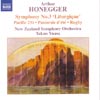Honegger Symphony No 3
An ideal introduction to Honegger’s rewarding orchestral soundworld
View record and artist detailsRecord and Artist Details
Composer or Director: Arthur Honegger
Genre:
Orchestral
Label: Naxos
Magazine Review Date: 10/2004
Media Format: CD or Download
Media Runtime: 65
Mastering:
Stereo
DDD
Catalogue Number: 8 555974

Tracks:
| Composition | Artist Credit |
|---|---|
| Symphony No. 3, 'Liturgique' |
Arthur Honegger, Composer
Arthur Honegger, Composer New Zealand Symphony Orchestra Takuo Yuasa, Conductor |
| (3) Symphonic Movements, Movement: Pacific 231, H53 |
Arthur Honegger, Composer
Arthur Honegger, Composer New Zealand Symphony Orchestra Takuo Yuasa, Conductor |
| (3) Symphonic Movements, Movement: Rugby, H67 |
Arthur Honegger, Composer
Arthur Honegger, Composer New Zealand Symphony Orchestra Takuo Yuasa, Conductor |
| (3) Symphonic Movements, Movement: No. 3, H83 |
Arthur Honegger, Composer
Arthur Honegger, Composer New Zealand Symphony Orchestra Takuo Yuasa, Conductor |
| Pastorale d'été |
Arthur Honegger, Composer
Arthur Honegger, Composer New Zealand Symphony Orchestra Takuo Yuasa, Conductor |
Author: Guy Rickards
The benchmark recording of Honegger’s Third Symphony (1945), his expression of outrage at the Second World War, is Karajan’s classic account, coupled with the Second (1941) and much reissued, which continues to elicit almost universal praise. The competition is formidable: Jansons’s identical coupling, almost as commanding as Karajan; Dutoit’s 1980s Bavarian version, part of a powerful complete cycle; more recently Fabio Luisi, in another cycle which deservedly drew warm praise in these pages. Takuo Yuasa is clearly undaunted. Right from the opening, beautifully recorded, he sets his mark on this dramatic score. His pacing in the Dies irae and Dona nobis pacem is thrilling, and the central De profundis is both beautiful and profound, with some fine wind playing. If Yuasa does not attain Karajan’s or Jansons’s intensity he still shapes a fine account, on a par with Luisi.
More than most interpreters, Yuasa emphasises the Prokofievian strand in Honegger’s orchestral textures, especially in Rugby and the Third ‘Mouvement symphonique’. Pacific 231 – again recorded with crystal clarity – is the exception. If Yuasa’s engine seems a touch underpowered compared to the very best in the field, such as Jansons, there’s a refreshing pragmatism to his approach that reveals the music, not just the sonic spectacle. Yuasa’s running order is also intriguing, casting a quite different light on the abstract No 3, placed centrally; hearing Pacific 231 as finale rather than surrogate overture adds to its impressive sense of momentum. There is nothing to choose between Yuasa and Luisi in the Mouvements symphonique; Dutoit is now at a disadvantage in sound quality. Yuasa gets more charm from Pastorale d’été (if not quite as much as Dutoit) which makes a charming end to the programme. Is it too much to hope that these forces record the delightful Fourth Symphony, Deliciae Basilienses?
More than most interpreters, Yuasa emphasises the Prokofievian strand in Honegger’s orchestral textures, especially in Rugby and the Third ‘Mouvement symphonique’. Pacific 231 – again recorded with crystal clarity – is the exception. If Yuasa’s engine seems a touch underpowered compared to the very best in the field, such as Jansons, there’s a refreshing pragmatism to his approach that reveals the music, not just the sonic spectacle. Yuasa’s running order is also intriguing, casting a quite different light on the abstract No 3, placed centrally; hearing Pacific 231 as finale rather than surrogate overture adds to its impressive sense of momentum. There is nothing to choose between Yuasa and Luisi in the Mouvements symphonique; Dutoit is now at a disadvantage in sound quality. Yuasa gets more charm from Pastorale d’été (if not quite as much as Dutoit) which makes a charming end to the programme. Is it too much to hope that these forces record the delightful Fourth Symphony, Deliciae Basilienses?
Discover the world's largest classical music catalogue with Presto Music.

Gramophone Digital Club
- Digital Edition
- Digital Archive
- Reviews Database
- Full website access
From £8.75 / month
Subscribe
Gramophone Full Club
- Print Edition
- Digital Edition
- Digital Archive
- Reviews Database
- Full website access
From £11.00 / month
Subscribe
If you are a library, university or other organisation that would be interested in an institutional subscription to Gramophone please click here for further information.




